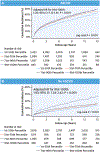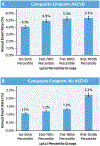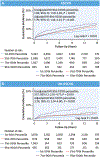Lipoprotein(a) and Major Adverse Cardiovascular Events in Patients With or Without Baseline Atherosclerotic Cardiovascular Disease
- PMID: 38418000
- PMCID: PMC12161880
- DOI: 10.1016/j.jacc.2023.12.031
Lipoprotein(a) and Major Adverse Cardiovascular Events in Patients With or Without Baseline Atherosclerotic Cardiovascular Disease
Abstract
Background: Lipoprotein(a) [Lp(a)] is associated with an increased risk of atherosclerotic cardiovascular disease (ASCVD). However, whether the optimal Lp(a) threshold for risk assessment should differ based on baseline ASCVD status is unknown.
Objectives: The purpose of this study was to assess the association between Lp(a) and major adverse cardiovascular events (MACE) among patients with and without baseline ASCVD.
Methods: We studied a retrospective cohort of patients with Lp(a) measured at 2 medical centers in Boston, Massachusetts, from 2000 to 2019. To assess the association of Lp(a) with incident MACE (nonfatal myocardial infarction [MI], nonfatal stroke, coronary revascularization, or cardiovascular mortality), Lp(a) percentile groups were generated with the reference group set at the first to 50th Lp(a) percentiles. Cox proportional hazards modeling was used to assess the association of Lp(a) percentile group with MACE.
Results: Overall, 16,419 individuals were analyzed with a median follow-up of 11.9 years. Among the 10,181 (62%) patients with baseline ASCVD, individuals in the 71st to 90th percentile group had a 21% increased hazard of MACE (adjusted HR: 1.21; P < 0.001), which was similar to that of individuals in the 91st to 100th group (adjusted HR: 1.26; P < 0.001). Among the 6,238 individuals without established ASCVD, there was a continuously higher hazard of MACE with increasing Lp(a), and individuals in the 91st to 100th Lp(a) percentile group had the highest relative risk with an adjusted HR of 1.93 (P < 0.001).
Conclusions: In a large, contemporary U.S. cohort, elevated Lp(a) is independently associated with long-term MACE among individuals with and without baseline ASCVD. Our results suggest that the threshold for risk assessment may be different in primary vs secondary prevention cohorts.
Keywords: lipoprotein(a) cohort; lipoprotein(a) therapies.
Copyright © 2024 American College of Cardiology Foundation. Published by Elsevier Inc. All rights reserved.
Conflict of interest statement
Funding Support and Author Disclosures This study was funded, in part, by Amgen Inc. Dr Januzzi is a Trustee of the American College of Cardiology; has received grant support from Abbott, Applied Therapeutics, HeartFlow Inc, Innolife, and Roche Diagnostics; has received consulting income from Abbott, AstraZeneca, Bayer, Beckman, Boehringer Ingelheim, Janssen, Novartis, Merck, and Roche Diagnostics; and participates in clinical endpoint committees/data safety monitoring boards for Abbott, AbbVie, Bayer, CVRx, Intercept, Pfizer, and Takeda. Drs Booth III, López, and Kent are employees and shareholders of Amgen Inc. Dr Bhatt has served on the Advisory Board of Angiowave, Bayer, Boehringer Ingelheim, CellProthera, Cereno Scientific, Elsevier Practice Update Cardiology, High Enroll, Janssen, Level Ex, McKinsey, Medscape Cardiology, Merck, MyoKardia, NirvaMed, Novo Nordisk, PhaseBio, PLx Pharma, and Stasys; has served on the Board of Directors of American Heart Association New York City, Angiowave (stock options), Bristol Myers Squibb (stock), DRS.LINQ (stock options), and High Enroll (stock); has served as a consultant for Broadview Ventures, Hims, SFJ, and Youngene; has served on Data Monitoring Committees for Acesion Pharma, Assistance Publique-Hôpitaux de Paris, Baim Institute for Clinical Research (formerly Harvard Clinical Research Institute, for the PORTICO trial, funded by St. Jude Medical, now Abbott), Boston Scientific (Chair, PEITHO trial), Cleveland Clinic, Contego Medical (Chair, PERFORMANCE 2), Duke Clinical Research Institute, Mayo Clinic, Mount Sinai School of Medicine (for the ENVISAGE trial, funded by Daiichi-Sankyo; for the ABILITY-DM trial, funded by Concept Medical; and for ALLAY-HF, funded by Alleviant Medical), Novartis, Population Health Research Institute, and Rutgers University (for the National Institutes of Health-funded MINT Trial); has received honoraria from the American College of Cardiology (Senior Associate Editor, Clinical Trials and News, ACC.org; Chair, ACC Accreditation Oversight Committee), Arnold and Porter law firm (work related to Sanofi/Bristol Myers Squibb clopidogrel litigation), Baim Institute for Clinical Research (formerly Harvard Clinical Research Institute; RE-DUAL PCI clinical trial steering committee funded by Boehringer Ingelheim; AEGIS-II executive committee funded by CSL Behring), Belvoir Publications (Editor-in-Chief, Harvard Heart Letter), Canadian Medical and Surgical Knowledge Translation Research Group (clinical trial steering committees), CSL Behring (American Heart Association lecture), Cowen and Company, Duke Clinical Research Institute (clinical trial steering committees, including for the PRONOUNCE trial, funded by Ferring Pharmaceuticals), HMP Global (Editor-in-Chief, Journal of Invasive Cardiology), Journal of the American College of Cardiology (Guest Editor; Associate Editor), K2P (Co-Chair, interdisciplinary curriculum), Level Ex, Medtelligence/ReachMD (CME steering committees), MJH Life Sciences, Oakstone CME (Course Director, Comprehensive Review of Interventional Cardiology), Piper Sandler, Population Health Research Institute (for the COMPASS operations committee, publications committee, steering committee, and USA national co-leader, funded by Bayer), WebMD (CME steering committees), and Wiley (steering committee); served as Deputy Editor of Clinical Cardiology; is named on a patent for sotagliflozin assigned to Brigham and Women's Hospital who assigned to Lexicon (neither he nor Brigham and Women's Hospital receive any income from this patent); has received research funding from Abbott, Acesion Pharma, Afimmune, Aker Biomarine, Alnylam, Amarin, Amgen, AstraZeneca, Bayer, Beren, Boehringer Ingelheim, Boston Scientific, Bristol Myers Squibb, Cardax, CellProthera, Cereno Scientific, Chiesi, CinCor, Cleerly, CSL Behring, Eisai, Ethicon, Faraday Pharmaceuticals, Ferring Pharmaceuticals, Forest Laboratories, Fractyl, Garmin, HLS Therapeutics, Idorsia, Ironwood, Ischemix, Janssen, Javelin, Lexicon, Lilly, Medtronic, Merck, Moderna, MyoKardia, NirvaMed, Novartis, Novo Nordisk, Otsuka, Owkin, Pfizer, PhaseBio, PLx Pharma, Recardio, Regeneron, Reid Hoffman Foundation, Roche, Sanofi, Stasys, Synaptic, The Medicines Company, Youngene, and 89Bio; has received royalties from Elsevier (Editor, Braunwald’s Heart Disease); has served as site co-investigator for Abbott, Biotronik, Boston Scientific, CSI, Endotronix, St. Jude Medical (now Abbott), Philips, SpectraWAVE, Svelte, and Vascular Solutions; is a Trustee of the American College of Cardiology; and has performed unfunded research for FlowCo. Dr Blankstein has received research support and consulting fees from Amgen Inc and Novartis Inc. All other authors have reported that they have no relationships relevant to the contents of this paper to disclose.
Figures






Comment in
-
Lipoprotein(a): Ready for Prime Time?J Am Coll Cardiol. 2024 Mar 5;83(9):887-889. doi: 10.1016/j.jacc.2024.01.004. J Am Coll Cardiol. 2024. PMID: 38418001 No abstract available.
References
-
- Kamstrup PR, Benn M, Tybjaerg-Hansen A, Nordestgaard BG. Extreme lipoprotein(a) levels and risk of myocardial infarction in the general population: the Copenhagen City Heart Study. Circulation. 2008;117(2):176–184. - PubMed
-
- Kamstrup PR, Tybjaerg-Hansen A, Steffensen R, Nordestgaard BG. Genetically elevated lipoprotein(a) and increased risk of myocardial infarction. JAMA. 2009;301(22):2331–2339. - PubMed
-
- Kamstrup PR, Tybjaerg-Hansen A, Nordestgaard BG. Elevated lipoprotein(a) and risk of aortic valve stenosis in the general population. J Am Coll Cardiol. 2014;63(5):470–477. - PubMed
Publication types
MeSH terms
Substances
Grants and funding
LinkOut - more resources
Full Text Sources
Medical
Miscellaneous

